111 Search Results for rating scale
August 30, 2013
by Robin Parker -
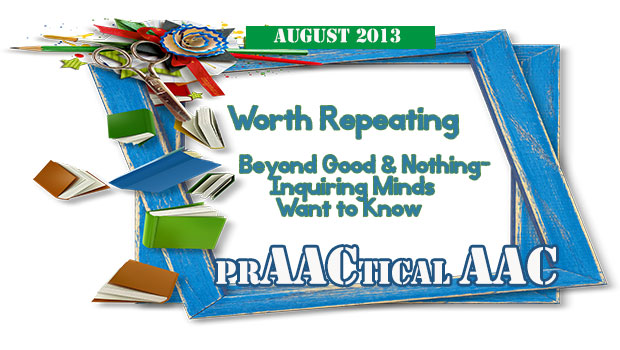
by Carole Zangari, originally published on August 27, 2012 “How was school?” (Good) “What did you do?” (Nothing) This scenario plays out in many cars and kitchens in the after school hours and it can be hard to know who is more frustrated: the kids for being asked or the parents for not getting satisfactory answers. And still, we repeat the process day after day. Of course, we want to know the fine details of what happened and how our children felt, but in some cases, we’d settle for ANY school-related conversation at all. I’ll be the first to admit that it took me way too long to get the hang of how to get information about my children’s school days, and it seemed like just when I did, pow! They were pre-teens and then teenagers. New rule book. Here are some ‘lessons learned’ along the way about those afterschool conversations and... [Read More...]
July 20, 2013
by Robin Parker -
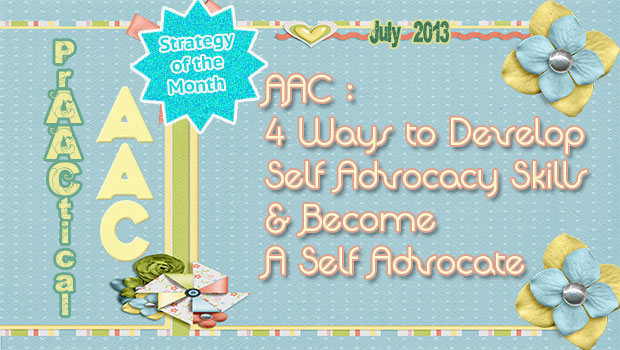
Self Advocacy comes in many shapes and forms for all learners. We all need to have a level of self advocacy skills to have a positive self-esteem, to continue a path of life long learning, and to defend and protect ourselves in situations that potentially can be harmful. The teaching of self advocacy begins with learning to request and protest but goes way beyond that for ALL learners. For those with AAC needs, specific strategies and direct instruction are often necessary to make self advocacy a comprehensive and robust skill. Self advocacy skills are a priority for older learners so for our Strategy of the Month, we will discuss some ways to help develop self advocacy skills beyond the requesting and protesting levels. We hope to build strong self advocacy skills for ALL learners. Rating Scales– Teach the use of rating scales to help AAC learners give their opinions on... [Read More...]
June 29, 2013
by Carole Zangari -
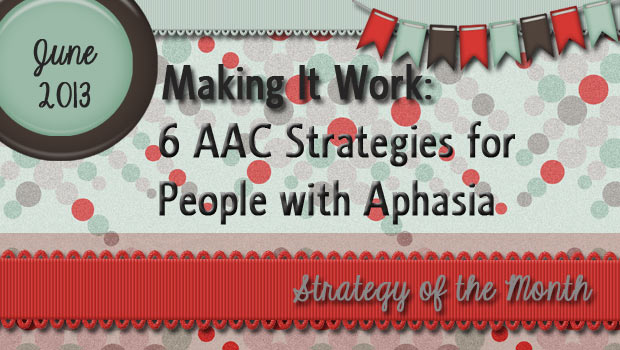
People with aphasia are often most successful when a number of different strategies are combined. In this post, we discuss a number of strategies that we can use in our therapy and teach to communication partners. Augmented Input We’ve written so many posts about aided language input that we’re almost embarrassed to bring it up again. Almost. It seems like no matter which age group or clinical population is the subject of our post, that strategy plays a central role. It is the same for people with aphasia with one exception. They benefit from a broader array of input cues, such as gestures, writing, and even pantomime. Augmented input is the term that is used to refer to oral language that is supplemented with pictures, print, gestures, pantomime, and the use of objects in the environment. By using these things as you speak, you enhance the ability of the person... [Read More...]
June 22, 2013
by Robin Parker -
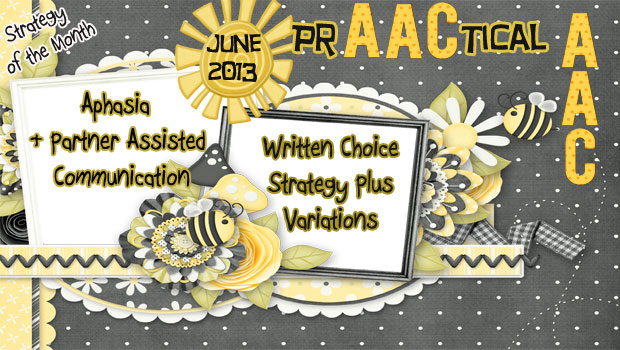
This month, we have enjoyed writing about communication strategies for aphasia. Partner supported communication is the platform for many of the effective techniques we use to help people with aphasia initiate, maintain, or terminate communication and conversation. We have talked about assessment strategies, communication books, and alphabet & topic supplementation. Now it is time to discuss the written choice strategy. The written choice strategy is fairly easy to implement, can look natural, and can result in seamless detailed conversation. Written choices are provided in the context of conversation and are displayed in an organized manner. What is It? The written choice strategy has the partner/facilitator generating written key-word choices that relate to the conversational topic. The written choices can be paired with text, pictures, drawings, symbols, and natural speech. The partner/facilitator writes possible answers to conversational questions in list form. The conversation is extended as continued written choices are offered... [Read More...]
June 3, 2013
by Robin Parker -
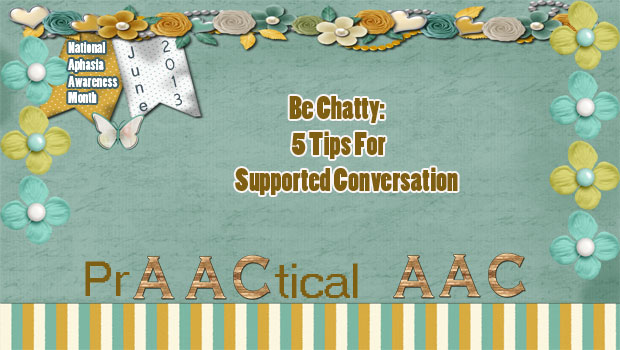
There are many strategies to support communication and conversation for individuals with significant aphasia. Conversation is about connecting with people. We engage in conversation about interesting and relevant experiences to help with connecting. To best connect and be part of conversation, there needs to be comprehension and expression from each communication partner. With aphasia, there is difficulty in these language areas, but it is not that language is lost, it is that it needs to be accessed differently. These quick start tips will support accessing conversation and connections. Write or Draw Key Words– When you are talking, write key words to support your spoken language. Gesture Key Words– When you are talking, supplement spoken language with gestures to illustrate a main point Show Related Photographs or Remnants– While you are talking, use photographs or some remnant of the an experience or event you are talking about. Written Choices to... [Read More...]
May 16, 2013
by Robin Parker -
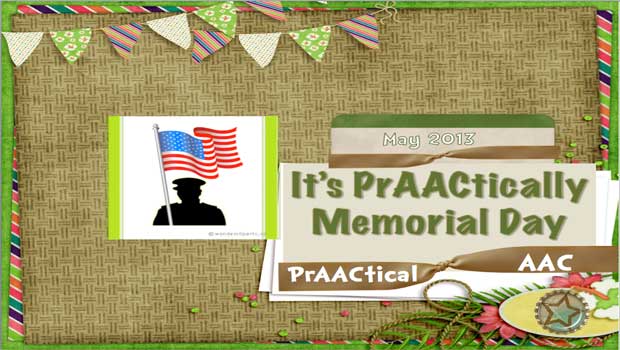
It’s PrAACtically Memorial Day! Memorial Day is prAACtically here. We remember, appreciate, and honor the people who have protected our freedoms. Getting ready so EVERYONE can participate is important. We wrote about memorial day last year and had found some good gluten-casein free Memorial Day recipes. There are even more resources today. Check out Gluten Free Memorial Day Weekend Menu and Recipe Ideas or Gluten Free Casein Free Applesauce Muffins. Cooking and baking provide meaningful language experiences as well as just plain fun. There are symbol based recipes on Pinterest at Picture Recipes and Visual Recipes for Children with Autism, and at Specialty Chef. There are also prAACtical AAC ways to teach about Memorial Day’s meaning as well as the typical memorial day vacations, activities, and events. Learning about Memorial Day Memorial Day Activity Board Memorial Day Vocabulary Cards Memorial Day Bingo Memorial Day Adapted Bingo Summer Pack Memorial Day After learning about Memorial... [Read More...]
March 13, 2013
by Robin Parker -

Saint Patrick’s Day is coming up. We love focusing on holidays in our sessions because it is a chance to teach new vocabulary and as importantly (if not more for some learners) it is a chance to teach social conversation about what many people in the community are talking about. Holiday’s also give us fun ways to focus on many other goals as well. The theme (in this case – a holiday) can serve as the platform for any goal that is appropriate. We just always ask ourselves (and our graduate students)- ‘What is the point’ or ‘What is the Goal’ when we have a great new themed activity. This is a time to work on core and fringe vocabulary, social conversation and interaction, play skills, and more. These are some fun activities matched to goals that we use to get ready for Saint Patrick’s Day. Surveys & or Questions–... [Read More...]
January 30, 2013
by Robin Parker -
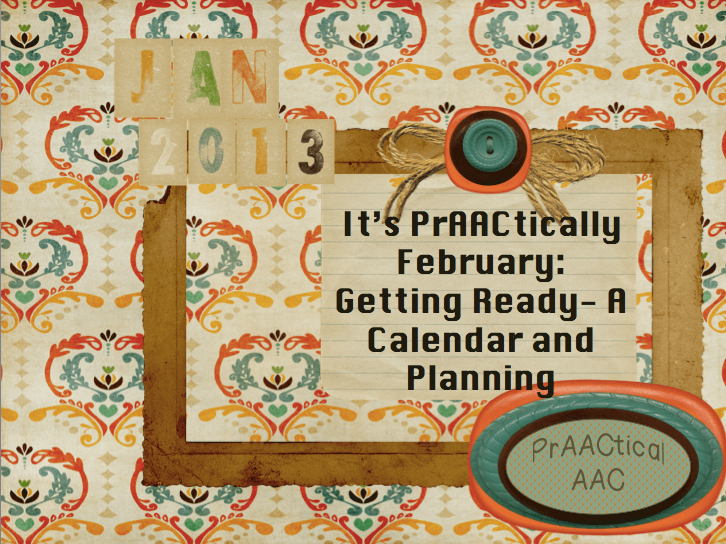
January is (was) a fairly crazy and busy month for us. After a late back to school week, the CARD Conference, the Dan Marino Foundation WalkAbout Autism, and ATIA Conference (hope to see you there), we got a bit of a late start on a few things. To stay ahead of ourselves, we want to end January by being ready for February…… For February, we have a calendar for incorporating AAC into everyday activities (it goes with yesterday’s post 28 things to do). Feel free to print out and share and use anyway you want to promote PrAACtical AAC. A PDF version (free) can be found at our Teachers Pay Teachers site. Our new Strategy of the Month (on Saturday) will focus on Communication & Language Beyond Requesting. There are no pre-requisites to learning and being immersed in ALL of the reasons to communicate (communication functions). For some learners, it... [Read More...]
January 29, 2013
by Robin Parker -
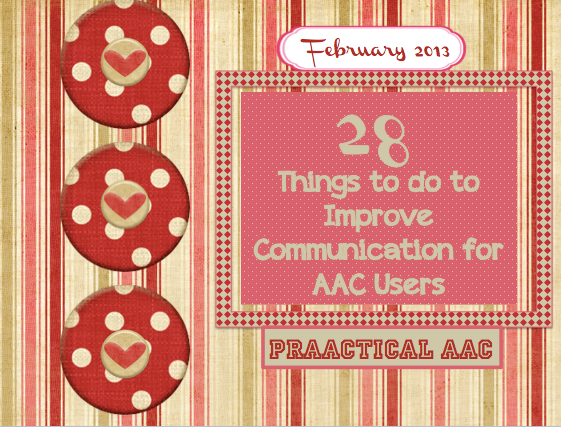
It’s almost February and and we were thinking about ways to encourage communication in a fun and meaningful way for the whole month. The best way we know is to build a visual language environment by providing lots of AAC modeling (Aided Language Input-ALI) and by using lots of visual supports. Here are some ideas to expand opportunities and/or to get started. We would love to know what works, what doesn’t, and any other ways you build visual language into everyday experiences. Use Aided Language Input (ALI) to say ‘I Love You’ . Make it part of a routine Offer learners a book choice board/choice book when deciding what book to read in speech-language therapy/classroom/home Use Aided Language Input (ALI) to tell how you feel when something is hard or difficult for you Use a ‘stop sign’ symbol to indicate an off limit area Use Aided Language Input (ALI) to... [Read More...]
December 29, 2012
by Carole Zangari -
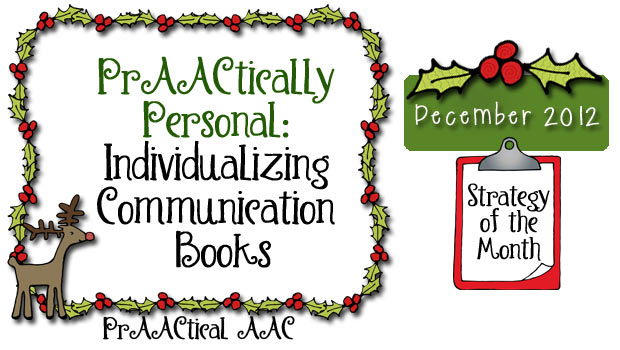
Custom tailored suit or off the shelf? Shoes that pinch or ones that are just snug? It stands to reason that when something fits well, we are more likely to wear it. Communication books, like clothes, have to ‘fit’ the user. But what does that really mean? When we’re ‘tailoring’ a communication book for someone who is learning to use AAC, there are three areas that we think about: How it looks, what it has inside, and how it ‘sounds.’ Appearance & Aesthetics As we’ve said before, everyone deserves communication tools that look great. Communication books should reflect the style and personality of the person who’ll be using it. Customizing a communication book doesn’t need to be expensive. You can use special papers for the cover or pages, and stickers to decorate. Here are some ideas to get you started. Send them shopping: There’s nothing that speaks to ownership like... [Read More...]









